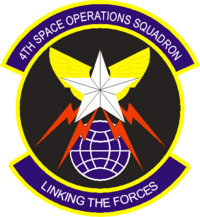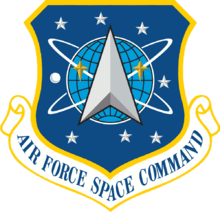4th Space Operations Squadron
| 4th Space Operations Squadron | |
|---|---|
|
4th Space Operations Squadron emblem | |
| Active | 19??-present |
| Country | United States |
| Branch | United States Air Force |
| Type | Satellite Operations |
| Role | Combat Support |
| Part of | USAF Squadron |
| Garrison/HQ | Schriever Air Force Base |
| Motto(s) | Linking the Forces |
| Engagements | World War II |
.png)
.png)
The United States Air Force's 4th Space Operations Squadron (4 SOPS) is a satellite operations unit located at Schriever AFB, Colorado. 4 SOPS controls the Milstar communication satellite constellation.
Mission
The mission of 4th SOPS is to ensure the Milstar system provides survivable, enduring, critical essential command and control communications through all levels of conflict for the president, the Secretary of Defense, and war fighting combatant commanders worldwide. 4th SOPS operates the $31 billion Milstar system executing communications management, satellite command and control, and ground segment maintenance for the Milstar constellation. 4th SOPS' motto "Linking the Forces" reflects Milstar's responsibility to enhance the nation's secure communications capability for today's military forces.[1]
History
Established under the 1st Photographic Group in May 1941. Performed aerial mapping primarily over the southwestern United States prior to the Pearl Harbor Attack using P-39 Airacobra sub-variants (F-2) which were equipped for the ground-attack and reconnaissance roles.
After the United States entry into World War II, flew aerial mapping missions over Western Canada and the Alaska Territory, mapping uncharted territory to support the building of the Alaska Highway. Deployed to South America in 1942–1943; mapping locations in British Guiana and Brazil for locations of emergency airfields as part of the development of the South Atlantic Transport Route.
Reassigned to 13th Air Force in late 1944; engaged in long-range mapping and reconnaissance over combat areas in support of seaborne landings in the Southwest Pacific Area (SWPA) and the liberation of the Philippines. Remained in the Pacific Theater after the Japanese Capitulation performing reconnaissance mapping flights over Japan, Korea and China. Unit largely demobilized on Okinawa. Inactivated in early 1946.
Reactivated in 1947 as part of Strategic Air Command. Mission was to gather intelligence on a global scale. Squadron operated RB-47H Medium bombers refitted for aerial reconnaissance and mapping mission. Flew day and night strategic reconnaissance missions over a global scale. Inactivated due to budget reductions in 1958.
Lineage
- Constituted as 4th Photographic Squadron on 15 May 1941
- Activated on 10 June 1941
- Redesignated: 4th Mapping Squadron on 13 January 1942
- Redesignated: 4th Photographic Mapping Squadron on 9 June 1942
- Redesignated: 4th Photographic Charting Squadron on 11 August 1943
- Redesignated: 4th Reconnaissance Squadron, Long Range, Photographic, on 15 June 1945
- Redesignated: 4th Reconnaissance Squadron, Very Long Range, Photographic, on 20 November 1945
- Inactivated on 14 April 1946
- Redesignated 4th Reconnaissance Squadron, Photographic, on 5 September 1947
- Activated in the Reserve on 20 September 1947
- Inactivated on 27 June 1949
- Redesignated 4th Strategic Reconnaissance Squadron, Medium, on 9 May 1952
- Activated on 28 May 1952
- Inactivated on 1 July 1958
- Redesignated 4th Space Operations Squadron on 1 April 1992
- Activated on 30 April 1992.
Assignments
|
|
Stations
|
|
Aircraft
- P-39/F-2 Airacobra, 1941–1942
- A-29 Hudson, 1942
- B-34 Lexington, 1943–1944
- B-24/F7 Liberator, 1943–1946
- Unknown, 1947–1949
- YRB/RBB-47E Stratojet, 1953–1958
- Satellites, 1992–present
Commanders
- Lt Col Charles Thompson (March 1992 to June 1993)
- Lt Col Kimber McKenzie (June 1993 to January 1995)
- Lt Col Michael Mantz (January 1995 to August 1996)
- Lt Col Philip Fitzjarrell (August 1996 to March 1999)
- Lt Col Allan Kirkman (March 1999 to February 2001)
- Lt Col Roger Teague (February 2001 to June 2003)
- Lt Col Ronald Huntley (June 2003 to June 2005)
- Lt Col John Shaw (June 2005 to June 2007)
- Lt Col Tommy Roberts (June 2007 to June 2009)
- Lt Col Doug Schiess (June 2009 to June 2011)[2]
- Lt Col Scott Trinrud (June 2011 to Jun 2013) [3]
- Lt Col Monte Munoz (June 2013 to July 2015) [4]
- Lt Col Sherman Johns (July 2015 to present)
References
![]() This article incorporates public domain material from the Air Force Historical Research Agency website http://www.afhra.af.mil/.
This article incorporates public domain material from the Air Force Historical Research Agency website http://www.afhra.af.mil/.
- MMaurer, Maurer, ed. (1982) [1969]. Combat Squadrons of the Air Force, World War II (PDF) (reprint ed.). Washington, DC: Office of Air Force History. ISBN 0-405-12194-6. LCCN 70605402. OCLC 72556.
- 4 SOPS official fact sheet


.jpg)